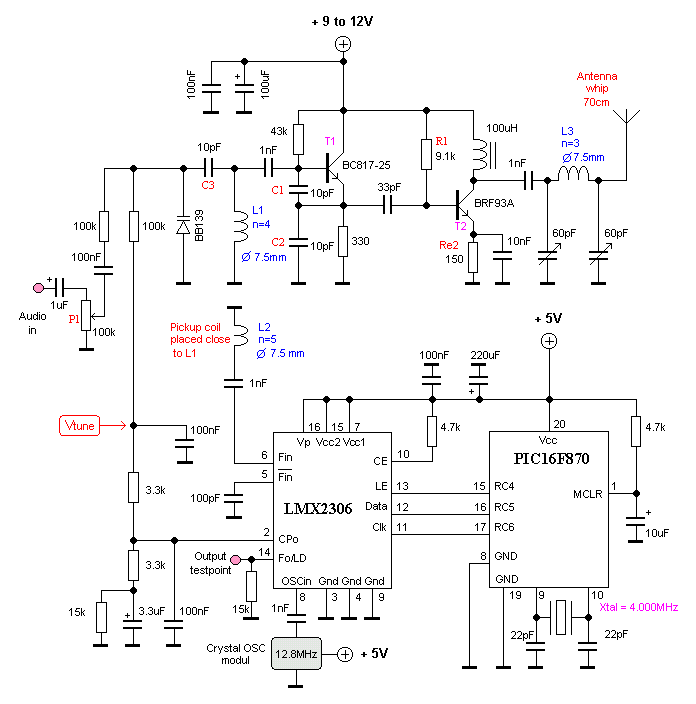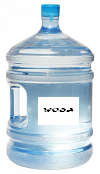|
500mW PLL FM Transmitter 88-108MHz

This PLL transmitter is controlled and the frequency is very stable
and can be programmed digitally. Transmitter will work 88-108 MHz
and output power up to 500mW. With a small change can set the
frequency of 50-150 MHz. The output power is often set to several
watts with transistors. So therefore I decided to build a simple
transmitter with great performances. The frequency of this
transmitter can easily be changed by software and space / compress
air coil. This transmitter is the oscillator colpitts. Oscillator is
a VCO (voltage controlled oscillator) which is set by the PLL
circuit and PIC micro controller. This oscillator is called the
Colpitts oscillator and voltage controlled to achieve the FM
(frequency modulation) and PLL control.
T1 must be HF transistors to work well, but in this case I use a
cheap and common BC817 transistor. LC tank oscillator needs to
oscillate properly.
In this case the LC tank consists of L1 with the C1, C2, C3, and
varicap BB139.
Coil parallel to the C1 and C2 in series. The same with the varicap
and C3.
You may think that L is parallel to the [(C1 / / C2) + (Varicap / /
C3)]
C3 will determine the value range VCO. Large value of C3 will be
broader in the range VCO can be.
PLL and Microcontroller
Oscillator is made to work as a ?Voltage Controlled Oscillator? VCO.
To control the frequency synthesizer circuit LMX 2306 has been
added. The PLL circuit has a pickup coil (L2) is connected to pin 6.
This coil should be placed close to the coil L1 to take some of the
energy oscillates.
The LMX2306 PLL in to use this frequency to adjust and lock the VCO
to the desired frequency.
Systems also need to set the external reference crystal. In this
case I use 12.8 MHz.
Pin 2 of MX2306 you will find the PLL filter to form a VM that is
set voltage of the VCO.
The PLL tries to arrange so that the oscillator frequency Fout kept
locked to the desired frequency.
The desired frequency programmed into the PIC EEPROM and clocked
into the synthesizer (LMX2306) at power up.
I will below explain how to program the EEPROM to different
frequencies.
In the pin14 of your synthesizer control output. In this output you
will find a reference frequency for testing.
(I must warn you that the signal is not symmetrical in form. Pulsa
positive only a few microseconds, so you will be hard to see on the
oscilloscope.) I solved by connecting it to 74HC4020 (14-stage
Binary Counter) to input pin 10 Hours. In Q0 (pin 9) you will have a
symmetrical square wave with a frequency half since the circuit is a
table. In Q1 pin 7 will be divided by 4, see data sheet for more
information.
LF input
You want to send audio must be connected to the audio input (left
schematic).
Will affect the signal and thus modulate the FM varicap RF carrier
frequency.
A potentiometer P1 was added to adjust the depth of modulation (FM
Wide or Narrow FM). You may have to play a bit with a value of P1
because it tends to modulate the lot. You may need to add the 500k ?
1M potentiometer only. You test and find out for himself.
Buffer stage
Here you find other HF transistors and work in the class C.
Resistor R1 and resistor Re2 regulate the flow of DC. In this case I
find that 9.1k will give a good output power and thus equal to 150.
If you want to increase the power should be lower Re2. You can add
another 150 ohm resistor in parallel.
In the table below I?ll show the output power with different
voltages and resistor values of Re2.
I advice you to not run the transmitter with a high output power.
Transistor I use is small and tends to be hot.
I advice you to run the unit from the 0 ? to 200mW. At the
transistor will 500mW pain ?* smiles *
At the output you will find a network T. This ?filter? will match
the transmitter to the antenna impedance output stage.
You have two variables 60pF capacitors to tune the transmitter for
best performance.
The antenna I use I a 1 / 4 wave whip antenna (wire) about 75cm
long.
Smaller antenna types, but not so good performance as a dipole.
With a dipole you will be more long distance transmitter.
How long can I pass?
It is a very difficult question because the environment affects the
transmission distance is very much.
In a city environment with concrete buildings transmitter will send
maybe 200m.
I will send a proposed open 2000m.
I did the test and filed with 70mW output power into a ?bad? whip
antenna is placed in the room I can send 200-300m to a park without
a problem. |

